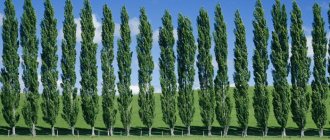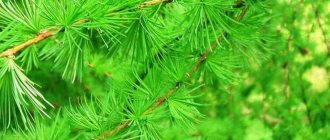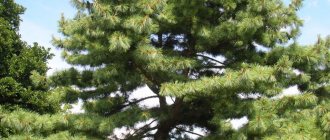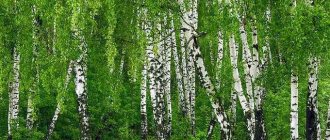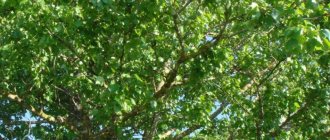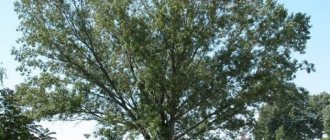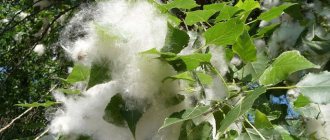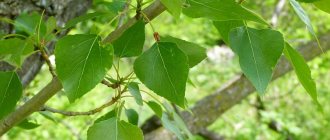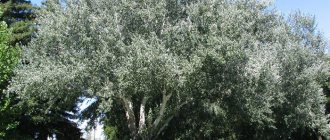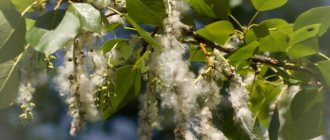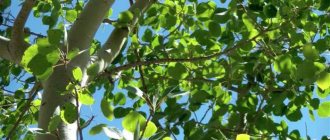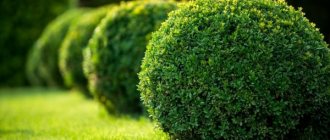Description of the plant
As you can see, the Latin name of the tree itself speaks of its popularity. And it originated from Ancient Greece, where even at that time these trees were grown in the streets and squares.
In nature, poplar most often grows near rivers, as it prefers moist soils. For example, aspen can grow on solonetz soils, and variegated poplar feels good on the sands of dunes. By the way, a forest where many poplars grow is called a poplar forest. One of the main features of these trees is their rapid growth, which is what made poplar so popular in urban landscaping.
Poplars in autumn
Poplar does not live long. Typically, a tree's growth slows down by the age of 50, and 60-80 years is its usual lifespan, although there are species that live up to 150 years. Poplar wood is highly susceptible to various fungal infections, which is why tree branches break easily and they themselves are short-lived.
Poplars are solid, large trees, sometimes 50-60 m tall, but more often they grow up to 40 m. The trunk is quite impressive, sometimes reaching up to a meter in thickness. Different species have crowns of different shapes - spherical, oval, pyramidal. The leaves of all poplars are simple, petiolate, usually oval with a pointed tip, sometimes lanceolate or with a notched edge. Most often smooth, but there are also pubescent ones.
poplar catkins
Poplars are mainly dioecious trees. Flowering occurs in early spring, even before blossoming or simultaneously with the unfolding of leaves; pollination usually occurs by wind. Small flowers are collected in inflorescences-catkins, respectively male and female. Trees begin to bloom and bear fruit at the age of 10 years.
Poplar fruits are small capsules with fluffy hairs. It is they who cause so much concern to city residents. Therefore, it is advisable to plant exclusively male plants for street landscaping.
Care
When creating a row of pyramidal poplars, the distance between the trees should be 1.5x3 m or 2.5x4 m. The poplar has a long and wide root system, and, accordingly, the planting hole should be up to 1 meter deep.
Poplar grows well in fertile soils that contain turf, peat and sand. If the soil is heavy, a drainage layer is placed at the bottom of the hole and one third of the hole is filled with it. Photophilous - sunny places are chosen for poplar alleys.
Poplar prefers nitrogen fertilizers. When planting, add nitroammophoska, calculating 100 g per square meter.
Water the tree generously. It takes approximately 25 liters of water to water one plant. In the first year after planting, water 2-3 times a month; watering is also necessary during periods of drought.
During the first years of a seedling’s life, it is recommended to loosen the circle around the trunk after each watering in order to retain more moisture. In the spring, after the snow melts, this area must be pierced to a depth of 15 centimeters. The same procedure is carried out in the fall, preparing the plant for winter. Trees older than 6 years do not need loosening; in this case, the soil near the trunk can be sown with lawn grass.
Immediately after planting and sufficient watering, the seedling is mulched with peat or sawdust.
Poplar tolerates winter cold and frost well and does not need special preparation for the cold period.
It is recommended to cut and prune these trees annually, starting from the first years of growth. The wounds after pruning are treated with a special garden lubricant. According to the pruning rules, two-thirds of the length of the branches is cut off, leaving a maximum of 20 cm on the tree. It is important to monitor the shape of the crown - it should be even.
The best time for pruning is winter or early spring. It must be carried out before the juices in the plant tissues begin to move.
In order to rejuvenate the plant, cut off its top (about one tenth of the height). At the end of the pruning procedure, the tree is fed, watered and the soil around the trunk is dug up.
Near the stump that remains from a tree that has been completely cut off, an armful of shoots quickly grows. It can also be trimmed and formed in this way.
Sweet poplar
The fragrant poplar grows in the eastern part of Siberia . It is also found in Mongolia and Northern China.
The light-loving tree reaches 20 m in height, has a dense ovoid-oval crown, a trunk with light yellowish-gray bark. It got its name for its fragrant and resinous (especially in spring) buds and young twigs. The leaves are bright green, leathery and shiny, oval in shape with a sharp tip at the top, quite dense, slightly whitish below. Small flowers form dangling earrings.
Sweet poplar foliage
Poplar pyramidal
Pyramidal poplar (Populus Pyramidalis) is a tall and slender tree, with a columnar crown, wide at the bottom and gradually tapering at the top, which makes the tree look like a cypress. It is believed that the homeland of this species is Asia Minor, but it is not known for sure.
Poplar pyramidal
The leaves are diamond-shaped, may be triangular, but not very large. The species is not very frost-hardy, but grows well in central Russia and in the south of Western Siberia. A magnificent tree for urban landscaping, good both in groups and in solitary planting, it forms beautiful alleys.
Pruning branches
Trimming branches to achieve the desired shape
After planting, save only one apical shoot that grows vertically upward - it is thanks to it that your plant will grow in height. Cone-shaped poplars, which grow branches very vigorously at the base of the trunk, do not require additional pruning of the branches - they naturally cope with the task of taking the necessary shape. For other types of poplars, regularly remove the side shoots growing on the trunk.
Pruning branches for plant care
Poplar tolerates human intervention well. So don’t be shy and cut off anything that seems unnecessary to you - any branches that violate its correct shape, or simply growing in an undesirable direction, just like dead and old shoots. When the poplar reaches thirty to forty years old, it will be necessary to pick up an ax.
How is poplar used?
And a few more words about the benefits and uses of poplar. We have already said about its indispensability in landscaping city streets. It is only necessary to add that the rapid growth, as well as the ability of its leaves to purify the air from gas and smoke, cannot be compared with any other type of tree. Therefore, in urban landscaping, poplar remains one of the most important and rational elements.
Poplars in the park
In addition, tree wood is very widely used for economic purposes: it is used to make paper and artificial silk, simple furniture and various containers are made, it is used for lumber and much more. And paint is obtained from poplar leaves and buds. This is such a wonderful and useful tree - our old friend poplar.
Main types of poplar in Russia
In the strip of coniferous and broad-leaved forests, rot-resistant crops such as black poplar, Berlin poplar, gray poplar, white poplar, fragrant poplar, balsam poplar and Petrovsky poplar are often planted. In the steppe zone, the most common types of poplar are: white, pyramidal, Canadian, laurel-leaved and Bollean. Breeders have developed many different hybrid poplar species for fast growth, but all of them do not tolerate severe frosts.
Some species of this plant are used industrially and are grown in special areas. Such breeds are necessary for the production of biofuel; among them, such species are used as: Gulliver, Kaliberginsky, Tronko and Arrowhead. Since the beginning of the year 2000, more than ten species of poplar, selectively bred by breeders from Armenia, have been brought to the territory of the Russian Federation.
These specimens are unique due to their accelerated growth, so in the shortest possible time the poplar can grow up to fourteen meters in height, with a trunk diameter of about twenty centimeters. And the weight of such a tree will be about one hundred kilograms.
Let's look at the main varieties of poplar
- Pyramid poplar. The country from which this type of poplar was brought is Afghanistan. The tree reaches thirty meters in height, the crown is narrow and resembles a column. It differs greatly from some other species in its ecological properties. The leaves are shaped like a diamond or triangle. Flowering begins early, leaves fall in mid-autumn. The lifespan of urban plantings depends on growing conditions. Great for planting a growing green wall.
- White poplar. A plant of this species grows quite quickly, but only if the soil is sufficiently fertile and well moistened. Over the course of a year, the tree grows about a meter in height and up to half a meter in width. It has a very powerful root system, which, depending on the amount of moisture in the ground, develops both on the surface and in the thickness of the soil. Root shoots are more than abundant and thrive in moist soil. Popularly also called silver.
IT IS IMPORTANT TO KNOW!
A natural fertilizer that increases soil fertility...
- Sedum or black poplar. The roots of this garden plant are very well developed, penetrate deep into the soil and, over time, diverge several meters to the sides. The use of its individual components is quite extensive, because the plant belongs to the category of phytoncides. Therefore, they have the ability to kill almost all known microbes that are considered harmful to the human body. They also protect fruit trees such as pears and apples, which can also safely grow in close proximity in the garden. It is used quite often in landscape design, as it reproduces quite well with the help of root suckers. Propagation by seeds is not recommended, since their germination rate is quite low. It is possible to use other methods of reproduction.
- Italian. The landing site should be selected based on certain characteristics, such as the occurrence of groundwater, the level of which must be at least four meters. Such varieties are not particularly winter-hardy, as they can withstand frosts down to -28°C, so their level of winter hardiness is average. Like white poplar Richardii, it grows up to forty meters, with a trunk diameter of about a meter.
When using the seed propagation method, it should be taken into account that the material very quickly loses its germination characteristics, therefore all necessary manipulations regarding their planting should be carried out as soon as possible. The spreading bushes of this plant help clean the air from gas and dust. In addition, poplar is extremely wind-resistant, so the planting site can be anywhere, even open. To avoid the formation of fluff, it is recommended to plant males.
Growing and propagating poplar
The poplar does not need a special description, because a representative of this species can be found in almost every garden or yard. Its use is quite extensive, but unlike Chinese, it can be grown in our region. There are only two ways to propagate poplar: cuttings and seeds.
When using the seed method
This method is fraught with a number of difficulties, so it is used extremely rarely. If, nevertheless, it was decided to propagate poplar using seeds, you will need to use fresh raw materials (collected yourself) or already stratified in a nursery. If the seeds were collected independently, then germination or planting should be done in the coming days, since their germination level is becoming lower every day.
When purchasing already prepared seeds, germination is carried out in a small container with specially prepared soil. Before planting a seed, it must undergo a stratification process. The first shoots should appear after a few months; there is no point in waiting longer.
Using the cutting method
Before choosing a seedling, you should check its roots for the presence of specific plaque, mold and stains, which would indicate improper care of the young plant. The rooting process proceeds quickly and should not cause any difficulties, but we are only talking about healthy seedlings. For germination, use a container with a small amount of water or moist soil. When harvesting independently, only annual shoots, as the thinnest branches, are subject to pruning. In a year, the sprout can grow up to 25 cm.
SENSATION!!
The easiest way to save gas is 25% - 50% less...
Young trees should be planted in the ground with the onset of the first warm spring days. Planting is done in moist soil, and the distance between the holes should be at least 20 cm. Only a third of the shoot should be visible above the ground. Watering in the first years should be regular and plentiful (stagnant water should be avoided). Already with the onset of autumn, cuttings can be planted in a permanent place.
Plant care
The distance between holes when planting poplar varieties such as Soviet or Turkestan should be at least 3.5 m. The root system of this tree is very extensive and it will need a lot of free space for proper development. The depth of the hole will be less than a meter.
A plant like large-leaved Aurora loves fertile soils (the presence of sand, peat and turf soil), so if these are not available, additional and regular fertilizer will be needed. If the site is dominated by a heavy type of soil, it is recommended to take care of a high-quality drainage layer. Varieties such as Ontario are extremely light-loving, so it is recommended to give preference to well-lit areas.
Mixtures containing nitrogen components are used as fertilizers. Additionally, nitroammophoska is used, which will need about 100 g per meter of area. Watering should be plentiful. About 30 liters of water are poured into the bottom of the hole at a time. 2-3 waterings per month are considered sufficient; during periods of drought this must be done more often.
Near the hole, after the snow melts, it is necessary to pierce the soil, which will avoid possible moisture stagnation in the future. The depth of the punctures will be no more than 15 cm. Similar manipulations should be carried out in the fall, before the onset of the first cold weather. Young roots are insulated with fallen leaves or mown grass. After planting, the area is mulched using sawdust and peat.
The plant does not need special preparation, as it tolerates frost extremely well. Sanitary and scheduled pruning is mandatory and is carried out several times a year. Garden putty will be needed to treat fresh wounds left by pruning shears. For pruning, count 2/3 of the length of the branch. The shape of the crown must be even and this must be monitored. If necessary, additional formative pruning is carried out, but only in the second year of the young plant’s life.
Early spring and winter are ideal for pruning. All procedures must be carried out either before the start of sap flow or after it. For rejuvenation, only the top part of the tree – the top – is removed. After pruning, the plant needs good feeding. The soil near the trunk is dug up and watered abundantly. New growth needs to be removed in a timely manner, otherwise in a few years the number of plants will increase significantly.
Image of Poplar
Under the tall gloomy old Poplars they signed important documents and took oaths.
During the era of revolutions, Poplar was a symbol of the people's struggle for freedom and rights.
At the same time, in Chinese traditions, wood meant the unity of opposites - yin and yang. Thanks to their flowers, Poplar leaves represented black and white, beginning and end.
In folk tales, Poplar personified a gentle and subtle nature. The Poplar leaves, like the Aspen leaves, trembled in the wind.
Since ancient times, it was believed that Poplars were able to absorb negative energy and protect the house from evil spirits. Like guards, tall trees stood on the streets in cities and villages. Many old-timers believe that trees cannot endlessly absorb evil thoughts and, in the end, give a lot to the world.
Types of wood used in construction
Depending on what you want to do, use one or another type of wood. First of all, you need to determine whether the bar you choose is a softwood or hardwood. Coniferous species have a sharper, resinous odor. In addition, the macrostructure of such wood species is better defined than that of deciduous trees. Coniferous wood species include pine, larch, fir, spruce, and cedar.
- Softwood
- Hardwood
- Fruit tree wood
- Rare wood
Softwood
The following coniferous wood species are distinguished:
Pine
most often used as a building material. The color of pine wood can be either reddish-yellow or pale yellow, and this does not in any way affect the working properties of the wood. The wood itself is durable, light, and easy to process. In addition, due to the high resin content, the wood is very resistant to rotting and weathering. The soft structure of wood allows it to easily absorb various dyes. This also applies to varnish coatings. When dried, pine wood practically does not warp.
Spruce
- the second most important and used coniferous species. Compared to pine, spruce is in many ways inferior to it. First of all, this is caused by a large number of knots in the wood. Yes, and it lends itself to processing somewhat less easily. The wood contained slightly less resin, which affects its poor resistance to atmospheric conditions.
Cedar
, or Siberian pine, is not inferior to spruce in construction qualities, and sometimes even surpasses it. Cedar wood is very easy to work with, but just like spruce, it is not resistant to decay.
Fir
, in its working qualities it is not much different from spruce: it is easy to process and practically does not accept chemicals. Just like spruce wood, it contains little resin, which is why the wood quickly rots in the open air without special treatment.
We recommend reading: 15 perennials that bloom all summer
Hardwood
Deciduous wood species are divided into hardwood and softwood. Wood of such species has practically no smell, and the smell intensifies only when the wood is freshly cut and processed. The most commonly used hardwoods are oak, birch and ash. The most common softwood species are aspen and alder.
Hardwood:
- Oak
- Beech
- Ash
- Birch
- Elm, birch bark, elm
- Nut
- Aspen
- Poplar
- Alder
- Linden
Oak
most often used in furniture making. Oak furniture is considered the most beautiful and durable; in addition, dense wood allows you to decorate the details with relief carvings. Also, the strength and hardness of wood contributes to the production of small fasteners, but at the same time durable connections. Oak is one of the few types of wood from which bent parts of various radii can be made. Due to the high content of tannins in wood, oak is considered the most rot-resistant of all deciduous species.
Beech
also applies to hardwood species. Its qualities are practically not inferior to oak. Just as good as oak, it can be processed, bent and impregnated with various chemical solutions. This quality contributes to the durability of the varnish and paint coating. But due to the fact that beech warps greatly when drying and is susceptible to rotting with the formation of wormholes, it is little used in the manufacture of furniture.
Ash
Most often used in the manufacture of furniture, veneer and parquet. This widespread use of ash is due, first of all, to the qualities of its wood: strong, tough, durable, resistant to decay, with a beautiful textured pattern, which warps little when dried and bends well when steamed.
Birch
used slightly less frequently than ash. First of all, this is due to low resistance to rotting, high shrinkage and susceptibility to warping. But the birch wood itself lends itself well to processing and makes it possible to make fine relief carvings. In addition, birch wood is well impregnated with chemicals and holds the varnish coating well.
We recommend reading: Which wallpaper is better: vinyl, non-woven or paper
Elm
,
birch bark
,
elm
represent one species. Among the main qualities that this rock has are: density, strength, viscosity and low porosity. When dried, the wood practically does not warp or crack. In addition, after steaming, the wood can bend as you wish. But due to its dense and finely porous structure, wood is difficult to polish, planed and painted.
Nut
has beautiful wood and is intended for finishing work. It is well processed, can be polished and impregnated with chemicals. Heavy and durable walnut wood does not warp or rot.
Aspen
has soft wood with few knots. Aspen lends itself well to processing, but due to its porous structure, small parts can break almost during their manufacture.
Poplar
also applies to soft-leaved species. This wood makes beautiful small parts and products. But poplar is prone to rotting, and when it dries out, it warps and cracks.
Alder
Of all softwood species, it is most often used in the construction of houses and in the manufacture of furniture. Alder practically does not rot, and therefore it is often used in the construction of log houses for wells. It is also well used in the construction of storage rooms - it itself does not smell and does not absorb odors.
Linden
Among all soft-leaved species, it is valued in the manufacture of large carved parts for furniture. In addition, this is one of the few types of wood that does not warp or crack when dried. Linden has a strong structure that is resistant to rotting.
Fruit tree wood
Among the rare species that are used in carpentry and carpentry, fruit tree wood occupies a large place. The wood used mainly is from wild trees.
Fruit tree wood:
Pear
It has dense, homogeneous, beautiful wood, which is used mainly for the manufacture of small parts. It is rare that you can get a large piece of board from a pear trunk. But this is not the only reason why pears are used to decorate furniture. Its wood is designed in such a way that when cutting, the blade perfectly removes chips both in the direction of growth of the fibers and against them. In addition, the wood is polished and impregnated perfectly. There is one more feature of the pear - it can equally be classified as both hard and soft species. The wood is quite soft when raw, but if it is soaked and then slowly dried, the wood becomes very hard. Among the shortcomings, we can name only one - without a varnish coating, the wood quickly darkens and begins to rot.
We recommend reading: Bathroom renovation with PVC panels | step-by-step installation instructions
Apple tree
belongs to a number of the most beautiful and durable wood species. But after drying, the tree warps and dries out very much, so it is preferable to work only with well-dried apple trees. Just like pear, it is used for finishing furniture, making household utensils and jewelry.
Plum
, like apple wood, is very susceptible to cracking and warping when dried. Hard and durable wood with many multi-colored veins is beautifully chipped and polished. Most often it is used to make jewelry and to emboss furniture. Turned utensils made from plum wood are also highly prized.
Rare wood
Above we looked at the types of wood that grow in our country. But in Russia, imported breeds are also very popular, which are most often used to make furniture and jewelry.
- Red tree
- Ebony
- Eucalyptus
- Fernambuc
- Rosewood
- Satin tree
Red tree
grows only in tropical forests. The very concept of “mahogany” does not mean belonging to a particular species, but represents a collection of various species, the wood of which is red in color. Mahogany wood is a soft species, can be processed well, is polished, and absorbs varnish. Mainly used for finishing furniture and premises. Because of its high price, it is rarely used entirely for furniture making.
Ebony
brought to us from Madagascar, Ceylon, and the island of St. Mauritius. Although wood cracks and splits well when dried, ebony is considered the most expensive. Its wood is dense, uniform, and black in color. Wood with barely noticeable layers of growth rings and vessels is highly valued. The least valued is wood with whitish layers and macrostructures and cores that stand out against the background of the wood. The wood practically does not rot, does not warp when dried, and absorbs varnish perfectly. The only thing that is not permissible to do with ebony is polishing: this only worsens the appearance.
We recommend reading: Filet with tomatoes and cheese: 5 photo recipes. 100% delicious
Eucalyptus
It has durable, heavy wood that is practically resistant to rotting. This property is explained by the high content of essential oils in its structure, which act in the same way as the resin in pine wood. Eucalyptus belongs to a small number of tree species that are difficult to process. Most often, the base of furniture is made from eucalyptus, then it is decorated with inserts from other species or covered with mahogany or ebony veneer.
Fernambuc
used in making mosaics. The most expensive are violin bows and conductor's batons made from this wood. When stored, fernambuco can change color from yellow with an orange tint to dark cherry or even black. Its wood practically does not rot and does not warp when dry. But a freshly felled tree dries out greatly, cracks and changes shape. In terms of severity in processing, it is second only to eucalyptus.
Rosewood
, like most breeds, is imported to Russia from South America. Rosewood wood has a porous structure and a dense arrangement of thin fibers. The peculiarity of this breed is its color, which, depending on the predominance of any shade, varies from light purple to dark brown with a violet tint. Like fernambuco, it can change color over time. If the wood is not polished upon completion of the work, the color of the wood may become almost black. The wood itself can be easily processed and is not subject to rotting. Most often, furniture and all kinds of decorations are made from rosewood.
Satin tree
It is rare among us, and therefore it is very highly valued. In Russia it is used only for the production of mosaic inserts and decorations. The wood of this species can have yellow, red and brown tints. But regardless of the color of the wood, there are always tiny sparkles in it, which, when varnished, give the finished product a satiny shine and the gloss of a soft flowing fabric.
We recommend reading: Design of a 2-room apartment: photo of renovation of Khrushchev-era buildings 44 m2 without redevelopment
Where does Poplar grow?
There are about 90 species of this tree. One of the rarest trees listed in the Red Book is Black Poplar.
Poplar belongs to the willow family. In nature, it can be found along river banks and on hillsides, however, it is most often found along roads and in parks in cities and towns.
Wild species are extremely sensitive to soil moisture. That is why Poplars are not found near swamps and swamps. Cultivated plants, on the contrary, take root well in almost any soil and even in heavily polluted areas.
Various types of Poplars grow in Siberia, Northwestern Russia, the Far East, America, Mexico, China and even East Africa.
Poplar grows very quickly and within 40 years reaches incredible sizes. The maximum age of such a Poplar reaches 150 years. There are known cases when the age of the Black Poplar was about 400 years.
Popular message topics
- Vitamins
For the proper development of the human body, it needs useful substances and vitamins. Vitamins have become the main element in the formation of many enzymes. Vitamins play an important role in metabolism. Some useful groups - Polymers Polymers
are high molecular weight (more than 10,000 daltons) compounds consisting of repeating low molecular weight structural units (monomers). The number of these units is called the degree of polymerization. - Indian culture
Indian culture is one of the oldest in the world and dates back about 4,500 years. The country has made significant achievements in architecture, mathematics and medicine. Language, religion, food and art are some of the components of Indian culture.
What does Poplar look like?
Poplar is a slender, tall tree with a strong, thick trunk and a silvery crown. The height of the Black Poplar sometimes reaches 40 meters, while the maximum recorded trunk girth is more than 4 meters.
The Poplar crown is very dense and wide. Over time, many branches dry out. It’s as if negative energy is drying up an old tree from the inside.
The bark of the common Poplar has a grayish tint and cracks over time.
The tree is dioecious. In summer, female flowers turn into that same poplar fluff - white snow against the backdrop of a sultry summer.
GCD competition in the senior group “Poplar - the tree of our region”
Svetlana Derkina
GCD competition in the senior group “Poplar - the tree of our region”
GCD in the senior group “ Polar – the tree of our region ”
Goal: creating a social development situation through search and research activities on the topic “ The poplar is the tree of our region ”
— introduce one of the types of pyramidal poplar - black poplar ;
- show the similarities and differences between ordinary poplar and black poplar ;
- develop curiosity in children.
- cultivate interest in learning about the world around us.
Preliminary work: conducting the experiment “Where does a leaf live in winter?”
: observations of the buds of
poplar placed in water (Keeping a diary of observations: swelling of the buds, the appearance of the first leaf, the appearance of roots. Conclusion: the leaf is in the bud, it “sleeps”
in the bud in winter)
-Who looks after the forest? What is such a person called? (Forester)
in our forest too. A lot of them. The main forester's name is Zinovy Mikhailovich Yuskov.
— Zinovy Mikhailovich found out about our experiment “Where does a leaf live in winter?”
. He was interested in this, he also wanted to do such an experiment, but he didn’t understand everything, and he had questions. Zinovy Mikhailovich sent these questions in the form of an audio letter. (Letter: Hello, children. I am asking you for help, I am Zinovy Mikhailovich Yuskov. From the Internet I learned about your interesting experience. Please help and answer the questions I have. Sincerely, Chief Forester of Khakassia.)
- “What did you do at first?”
(They took branches)
- “Which tree branches
did you take ?” (
Polars .) - Why poplars ? (This tree grows on a plot , in a city, in a park)
— “Did the leaves appear immediately?”
(No. First the buds swollen, burst, the tip of the leaf appeared, then a small leaf)
“What shape does a
poplar ?” (Has the shape of a heart, oval, smooth edges)
Task “Guys, here are the leaves of the trees . poplar leaves "
— Where does poplar ? (In the forest, in the city, in parks)
— “Is there any benefit from this tree ”
.
Is poplar a useful tree ? Does it need to be protected? What are the benefits of poplar ?
(Home for birds, small animals - mice, chipmunks, squirrels; produces oxygen, purifies the air from gnawing, medicine for animals) (Birds, animals are attached to a tree using a magnet, clean air)
- Poplar – medicinal tree?
- You guys know that our Sorsky poplar has a brother - black poplar . It grows where it is warm: in Crimea, near Moscow, in Leningrad.
Task “Look and find similarities and differences”
Black poplar
Common poplar
— It is listed in the Red Book. Do you know what the red book is?
What animals and plants do you know from the Red Book? why were they brought there? (Rare birds, animals, and plants are included in the Red Book. They were destroyed, exterminated, and were not taken care of. There are few left.)
“There are n’t many black poplars left . But our poplar is not listed in the Red Book. We protect it, we take care of it. How do we protect it? What will we do with the branches? (We will plant it in the park, on the site)
— How else to plant a poplar ? (seeds)
-What did you do in class? - helped the forester.
-What does the forester know now? What have you learned? Will this be useful to you? Where will it be useful?
Summary of the final NOD in the first junior group for the second quarter “Wild animals of our region” Municipal Budgetary Preschool Educational Institution kindergarten No. 30 “Rodnichok” North Ossetia Alania, Mozdok. “Wild animals of ours.
Children's and parental information project "Trees of our land" in the senior group CHILDREN'S AND PARENTS INFORMATION PROJECT "THREES OF OUR EDGE" Type of project: informational Duration: long-term Participants: children.
Summary of educational activities for cognitive development “Birds of our region” in the middle group Topic: “Birds of our region” Purpose: 1. Expand children’s understanding of the birds of our region. 2. Continue to develop the ability to distinguish birds by.
Abstract of the educational activity “Poets and writers of our village and region” in the preparatory speech therapy group Abstract of the educational activity in the educational field “Cognitive development” (“Acquaintance with the social world”) Topic: Literary page “Poets.
Summary of educational activities on the cognitive development of children of senior preschool age, conversation on the topic “Folk crafts of our region” STATE BUDGETARY PRESCHOOL EDUCATIONAL INSTITUTION KINDERGARTEN OF GENERAL DEVELOPMENTAL TYPE No. 8 ADMIRALTEISKY DISTRICT OF ST. PETERSBURG.
Summary of a lesson on local history in the second junior group “Animals of our region” Purpose: To introduce children to the animals that live in the forests of the Southern Urals, to consolidate knowledge about animals. Software content: 1. Expansion.
Summary of a lesson on familiarization with the outside world in the senior group “Wild animals of our region” Purpose of the lesson: to summarize children’s knowledge about wild animals. Objectives of the lesson: Educational • Reinforce the names of wild animals and their young.
Organized educational activities for the senior group “Plants of our region” Main educational area: cognitive development Integration of educational areas: cognitive development, artistic and aesthetic.
Project “Wintering birds of our region” in the middle group Type of project: educational, research, creative. Duration: long term. Project participants: middle school children, teachers.
Source
The healing properties of Poplar
The bark, seeds and buds of the plant are used as medicine.
Poplar bark contains tannins, glycosides and alkaloids. Thanks to this, a decoction of the bark has a sedative effect and calms the nervous system.
At the same time, tannins have an astringent effect and are effective for stomach disorders.
Kidney decoctions effectively fight inflammation and increase the body's resistance.
An infusion of Poplar leaves is used as a wound healing agent.
There are drugs based on Poplar that can cope with depression and normalize sleep.
Poplar buds, ground into powder and mixed with other ingredients, are used for hair loss. This ointment can stimulate hair follicles.
Application of Poplar
Poplar wood is used in industry as a raw material for making paper, matches, plywood and even charcoal.
Despite the fact that Poplar wood is not a favorite material for carvers and joiners, it is very valuable. The tree is able to quickly reach its ripeness, therefore it is an important and rapid source of renewable natural resources.
Pine in this .
Many types of plants are unpretentious in the soil and are able to withstand increased air pollution, converting carbon dioxide into oxygen. That is why this plant has been planted in parks and along roads for many decades in a row.
Unfortunately, Poplar is also known for being a strong irritant for allergy sufferers. This fact was clearly not taken into account in Soviet times during the mass planting of Poplars in residential areas.
Breeding rules
There are two ways to propagate these trees - vegetatively and through sowing seeds. To grow poplar, in practice the vegetative method is most often used.
Poplar branches take root quite easily without any extra effort. Simply put them in a vessel with water or stick them into moist soil. One-year-old shoots of a tree are taken as cuttings, which are cut off before the intense movement of sap in the tissues of the trunk begins (as a last resort, this can be done when the buds begin to crack). The necessary shoots are easy to recognize: these are the thinnest branches from the ends of larger branches or from the top of the trunk. The buds and places of last year's leaves are quite noticeable on them. The length of such a shoot is, as a rule, up to 1 meter (shoots from the lower part of the crown are short). Do not use parts of old branches as cuttings; they may no longer have buds suitable for the development of a new plant.
The best time for planting seedlings is considered to be spring and autumn. This is when the tree takes root most easily. Poplar plantings begin as soon as the snow melts and continue until the new leaves have expanded halfway. In autumn, it is advisable to plant young trees when the leaves have mostly turned yellow and end after light frosts.
After young one-year branches are cut, they are divided into cuttings 15-20 cm long. It is important to ensure that there are several living buds left on each cutting (it is advisable that they be on the upper part of the cutting). The cuttings are planted in moist soil, top to top (special attention is paid to this), and in such a way that about a quarter of the cutting with buds remains above the ground. The distance between cuttings should be 10-15 cm. Planted cuttings require regular watering. With careful care, new shoots form from the buds and rapidly grow to 15 cm in height. Thus, by the beginning of autumn planting, seedlings up to one meter high are obtained.
As you can see, pyramidal poplar is a completely unpretentious tree to care for; no special conditions need to be created for it. That is why this seemingly ordinary tree has become an indispensable decoration of our streets and parks.
This slender tree with a columnar and narrow crown can reach a height of up to 30 meters, unless, of course, pruning is carried out in a timely manner. The dark green, triangular-shaped leaves open in April, sometimes at the same time as the flowers. This poplar is growing rapidly. Leaf fall begins in late October - early November. Although it may suffer from frost, it is capable of restoring the crown. It purifies the air perfectly and can become a real decoration of the garden.
Landing
If you decide to plant a row of pyramidal poplars, then the distance between plants should be 1.5x3 meters or 2.5x4 meters. The hole should be up to 1 meter deep, since the root system of poplars is deep and extensive. The root collar is at soil level or buried 1.5-2 cm. Soil mixture is turf soil, peat sand in a ratio of 3:2:2. Pyramid poplar is very light-loving. Choose a sunny place. Planting is carried out in the spring. If you plant in the fall, the plant may not take root. On heavy soils, drainage is required. They fill 1/3 of the depth of the hole.
Top dressing
When planting, apply nitroammophoska or complex fertilizer at the rate of 100 g per square meter.
Watering
Watering should be plentiful so that the soil is saturated with moisture to the depth of the roots - approximately 25 liters for each plant. In the first year, plantings are watered 2-3 times a month, as well as during the dry season.
Loosening and mulching
To preserve moisture, the tree trunk circles are loosened after each watering. In spring and autumn, bayoneting to a depth of 10-15 centimeters is required. After 6 years, there is no longer any need to loosen, and the tree trunk circles can be sown with lawn. You can mulch with humus, peat or sawdust immediately after planting and watering.
Preparing for winter
No special preparation is needed, since poplar is frost-resistant.
Haircut and trimming
Poplars tolerate shearing and pruning well and easily restore their crown. After pruning, wounds with a diameter of 2.5 cm are covered with garden putty. Pruning begins at an early age of the plant and is carried out annually. Cut off 2/3 of the length of the shoot, leaving 10-20 cm on the tree, while making sure that the shape of the crown is even. Heavy pruning is carried out in winter or early spring - before sap flow begins. A powerful growth forms from the stump, which also needs to be formed. If you want to rejuvenate the plant, then cut off the top - about 10% of the height. After heavy pruning, apply fertilizer, regularly water and loosen the tree trunk circle.
Poplar is a member of the Willow family, and belongs to a genus of fast-growing trees, the number of which, according to some sources, is about one hundred and ten million years old. By crossing some species, separate varieties of poplar, so-called hybrids, were obtained. Due to its high growth rate, this plant is often grown in energy forests and in their own summer cottages.
Poplar bears fruits in the form of a small capsule with small seeds. The seeds have a peculiar tuft of hairs, thanks to which poplar fluff can be observed when the seeds scatter. Poplars belong to the category of long-livers, which can grow for three hundred years. Already mature trees have a dark shade of the trunk and growths at the base of the roots.
The crown of the poplar is wide with branches spread out on the sides. The buds are covered with resin and are shaped like a cone or a large egg. The leaves are large, located on long petioles. The leaves are often triangular in shape, sometimes rhombic. During the flowering period, inflorescences begin to appear, mainly on dangling long catkins.
Flowering begins in mid-spring, after which leaves form. The fruits themselves ripen in early summer. Poplar grows best in Siberia, Central Asia and the European part of our country. Poplar can be found in parks and deciduous forests. To independently propagate the tree, it is recommended to plant both male and female specimens.
